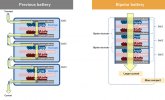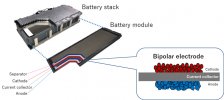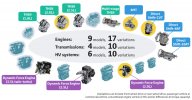You are using an out of date browser. It may not display this or other websites correctly.
You should upgrade or use an alternative browser.
You should upgrade or use an alternative browser.
Official Lexus Future Product & Powertrain Megathread
- Thread starter ssun30
- Start date
New Toyota Aqua https://global.toyota/en/newsroom/toyota/35584064.html
This new bipolar NiMH battery on Aqua is actually quite a big innovation. I'm happy to see instead of a boring larger Yaris hybrid Toyota actually has something new to offer.
>> In a bipolar battery module, individual cells are stacked directly on each other thanks to the bipolar electrode. This way the modules can be much smaller and require fewer components.
>> Because current flows directly across the entire surface area of the current collector (instead of through wire connections), current density can be a lot higher. Losses will be lower because resistance is lower.

>> Each battery module is a large plate of stacked cells instead of cylindrical/prismatic/blade shape. This way the packaging efficiency can be very high and there's more surface area for cooling.
>> I don't know the exact specifications but from the image it looks like there are 7 modules each with 24 stacked layers (168s1p, 201.6V). Gen 1 uses 20 modules each with 6 internal serial connections (120s1p, 144V).

The end result is 2.1x power output from the same volume (1.4x cells, 1.5x current/cell). Gen 1 Aqua has 144V 6.5Ah@25C so total output is only 23kW. On Gen 2 this number is 49kW, even higher than the 311V Li-ion pack used on LS/LC500h (44kW)!
This is why this new form factor is such a game changer. Without changing the battery chemistry they are able to outmatch the power density of Li-ion batteries. Now consider this form factor on BEVs, the charging speed will be much higher. The only drawback I see is a single point of failure will mean more voltage loss and each module will be more expensive to replace. But that is always the price you pay when going for more efficient form factors.
I think Toyota uses NiMH chemistry to test the feasibility of this new technology to use later on SSBs. I think this is how they will solve the low current density problem with SSBs. Bipolar electrodes are relatively new with only lead acid chemistry available. Li-ion bipolar batteries only started development very recently.
>> In a bipolar battery module, individual cells are stacked directly on each other thanks to the bipolar electrode. This way the modules can be much smaller and require fewer components.
>> Because current flows directly across the entire surface area of the current collector (instead of through wire connections), current density can be a lot higher. Losses will be lower because resistance is lower.

>> Each battery module is a large plate of stacked cells instead of cylindrical/prismatic/blade shape. This way the packaging efficiency can be very high and there's more surface area for cooling.
>> I don't know the exact specifications but from the image it looks like there are 7 modules each with 24 stacked layers (168s1p, 201.6V). Gen 1 uses 20 modules each with 6 internal serial connections (120s1p, 144V).

The end result is 2.1x power output from the same volume (1.4x cells, 1.5x current/cell). Gen 1 Aqua has 144V 6.5Ah@25C so total output is only 23kW. On Gen 2 this number is 49kW, even higher than the 311V Li-ion pack used on LS/LC500h (44kW)!
This is why this new form factor is such a game changer. Without changing the battery chemistry they are able to outmatch the power density of Li-ion batteries. Now consider this form factor on BEVs, the charging speed will be much higher. The only drawback I see is a single point of failure will mean more voltage loss and each module will be more expensive to replace. But that is always the price you pay when going for more efficient form factors.
I think Toyota uses NiMH chemistry to test the feasibility of this new technology to use later on SSBs. I think this is how they will solve the low current density problem with SSBs. Bipolar electrodes are relatively new with only lead acid chemistry available. Li-ion bipolar batteries only started development very recently.

カローラスポーツGR 最終デザイン判明&300ps+6iMTで来夏デビュー!! - 自動車情報誌「ベストカー」
ベストカーがかねてから「カローラスポーツGRMN」としてお伝えしてきたトヨタ カローラの新型車。その最新情報が入ってきた! 今回入手した新たなデザイン情報を前回掲載のCGと比べて解説する! ※本稿は2021年4月のものです文・予想CG/…
・ Overall length x width x height: 4375 x 1810 x
1450mm
・Wheelbase: 2640mm・ Vehicle weight: 1340kg
・ Engine: direct 3, 1.6L direct injection turbo
・ Maximum output / maximum torque: 300ps / 37.7kgm
・ Drive system: 4WD
・ Transmission: 6iMT
・ Suspension (F / R): Strut / Double wishbone
・ Expected price: 5 million yen
How accurate do you think these stats are? IMO the kerb weight seems unusually light for a modern C-segment AWD hot hatchback.
Gecko
Administrator
- Messages
- 5,146
- Reactions
- 12,661
Corolla Sport GR expected specifications
カローラスポーツGR 最終デザイン判明&300ps+6iMTで来夏デビュー!! - 自動車情報誌「ベストカー」
ベストカーがかねてから「カローラスポーツGRMN」としてお伝えしてきたトヨタ カローラの新型車。その最新情報が入ってきた! 今回入手した新たなデザイン情報を前回掲載のCGと比べて解説する! ※本稿は2021年4月のものです文・予想CG/…bestcarweb.jp
・ Overall length x width x height: 4375 x 1810 x
1450mm
・Wheelbase: 2640mm・ Vehicle weight: 1340kg
・ Engine: direct 3, 1.6L direct injection turbo
・ Maximum output / maximum torque: 300ps / 37.7kgm
・ Drive system: 4WD
・ Transmission: 6iMT
・ Suspension (F / R): Strut / Double wishbone
・ Expected price: 5 million yen
How accurate do you think these stats are? IMO the kerb weight seems unusually light for a modern C-segment AWD hot hatchback.
The regular Corolla Hatch is 3,060lbs, so assuming it lost ~100lbs while adding AWD seems unlikely to me, but then again, I guess it's possible that the 3cyl and its components weigh less than the 4cyl. Maybe it checks out after all?
flipside909
Premium Member
- Messages
- 317
- Reactions
- 372
The regular Corolla Hatch is 3,060lbs, so assuming it lost ~100lbs while adding AWD seems unlikely to me, but then again, I guess it's possible that the 3cyl and its components weigh less than the 4cyl. Maybe it checks out after all?
Only true if you're a global expert automotive engineer specialist.
https://toyota-club.net/files/faq/21-07-20_faq_f33-engine_en.htm
Recommended read on F33A-FTV diesel.
Block has same bore and stroke as 1VD. Compacted graphite iron closed deck for max durability. There is an extra arch connecting two cylinder banks for even more rigidity. Engine weight is 266kg (586lbs), 30% lighter than the very heavy 1VD (372kg/820lbs). But that's still a lot of weight to absorb all the stress.
Isn't this what Supra fans asked for in the first place? The future workhorse for F cars should be a petrol variant of F33 with shorter stroke.
Recommended read on F33A-FTV diesel.
Block has same bore and stroke as 1VD. Compacted graphite iron closed deck for max durability. There is an extra arch connecting two cylinder banks for even more rigidity. Engine weight is 266kg (586lbs), 30% lighter than the very heavy 1VD (372kg/820lbs). But that's still a lot of weight to absorb all the stress.
Isn't this what Supra fans asked for in the first place? The future workhorse for F cars should be a petrol variant of F33 with shorter stroke.
F1 Silver Arrows
Expert
- Messages
- 2,572
- Reactions
- 4,180
https://toyota-club.net/files/faq/21-07-20_faq_f33-engine_en.htm
Recommended read on F33A-FTV diesel.
Block has same bore and stroke as 1VD. Compacted graphite iron closed deck for max durability. There is an extra arch connecting two cylinder banks for even more rigidity. Engine weight is 266kg (586lbs), 30% lighter than the very heavy 1VD (372kg/820lbs). But that's still a lot of weight to absorb all the stress.
Isn't this what Supra fans asked for in the first place? The future workhorse for F cars should be a petrol variant of F33 with shorter stroke.
The rumor was that the new GR Supra would get a gas version of the BMW B57 diesel engine. The B57 has a CGI architecture which should make it very similar to a JZ albeit many order of magnitudes more modernized.
Alas the rumor ended up being false and we got the B58, which is in all honesty still amazing. GR Supras are now hitting 8's in the quarter mile with relative ease and with an all turbo (with supporting modifications) GR Supra with no nitrous, no port injection and very minor modifications to the engine itself is hitting well in the high 700 horsepower mark.
The only issue that has revealed itself at those numbers is the slippage of the ZF8HP51 transmission, and that is remedied with a beefier transmission upgrade as new developments start to become available. It's shocking how fast these things are and are handing supercars butts to them on a silver platter.
it will always be slower than an AWD M4The rumor was that the new GR Supra would get a gas version of the BMW B57 diesel engine. The B57 has a CGI architecture which should make it very similar to a JZ albeit many order of magnitudes more modernized.
Alas the rumor ended up being false and we got the B58, which is in all honesty still amazing. GR Supras are now hitting 8's in the quarter mile with relative ease and with an all turbo (with supporting modifications) GR Supra with no nitrous, no port injection and very minor modifications to the engine itself is hitting well in the high 700 horsepower mark.
The only issue that has revealed itself at those numbers is the slippage of the ZF8HP51 transmission, and that is remedied with a beefier transmission upgrade as new developments start to become available. It's shocking how fast these things are and are handing supercars butts to them on a silver platter.
F1 Silver Arrows
Expert
- Messages
- 2,572
- Reactions
- 4,180
it will always be slower than an AWD M4
?
bogglo
Admirer
- Messages
- 650
- Reactions
- 873
IS500 or NX? or is it going to be a debut?
"A new Lexus will join the Lexus IS 350 F Sport at the Fashionlsladn pop-up in Newport Beach, CA. SSee it for yourself August 18-September 4"
- Messages
- 32
- Reactions
- 19
wheres the F models? LC-F, LS-F
mikeavelli
Moderator
- Messages
- 7,505
- Reactions
- 16,672
Yup for those in Southern Cali it’s the Launch Edition there until Sept 4th.
It's an IS500!
I can share initially this car was going to the NYIAS but when it was canned Lexus was wise enough to move swiftly to showcase this beauty elsewhere.
- Messages
- 2
- Reactions
- 2
I'm a big fan of Lexus cars, so I'm genuinely wondering what their following models will be. All of my family's cars are from Lexus, and I was very picky when creating my collection. I even got two of my vehicles shipped by auto transport quotes from the other side of the country just to own them. I'm now expecting the 2022 Lexus ES that should arrive in dealerships during this fall. I saw a few pictures of it, and I fell in love, so I'm looking forward to seeing what's next for the company in the future. Although the RX is still my favorite car from Lexus, having a few more never hurts.
So is the consensus that NOW there will only be one powertrain more powerful than the 3.5 TT? And we all assume its the 3.5 TT Hybrid iForce MAX engine?
I know this diagram came out pre-COVID, so its fair to say the maybe the largest engine on here was a TTV8 that got scrapped?
I know this diagram came out pre-COVID, so its fair to say the maybe the largest engine on here was a TTV8 that got scrapped?
Attachments
Gecko
Administrator
- Messages
- 5,146
- Reactions
- 12,661
So is the consensus that NOW there will only be one powertrain more powerful than the 3.5 TT? And we all assume its the 3.5 TT Hybrid iForce MAX engine?
I know this diagram came out pre-COVID, so its fair to say the maybe the largest engine on here was a TTV8 that got scrapped?
Yes and no. I get the sense a hybrid V8 could happen down the line, but it would need to meet Lexus' new, stricter internal emissions targets and I'm not sure a V8 can do that, even with electrification. It's too premature to say.
So, I think 3.5L TT V6 + hybrid will be the top of the pecking order for quite some time. With IS 500, LC 500, GX 460 and RC F, I think the UR V8 will be in production through the 2024MY, so that slots in somewhere too.
F1 Silver Arrows
Expert
- Messages
- 2,572
- Reactions
- 4,180
Yes and no. I get the sense a hybrid V8 could happen down the line, but it would need to meet Lexus' new, stricter internal emissions targets and I'm not sure a V8 can do that, even with electrification. It's too premature to say.
So, I think 3.5L TT V6 + hybrid will be the top of the pecking order for quite some time. With IS 500, LC 500, GX 460 and RC F, I think the UR V8 will be in production through the 2024MY, so that slots in somewhere too.
But isn't the chart about new engines only? It has to be a V8 or something.
-
This site uses cookies to help personalise content, tailor your experience and to keep you logged in if you register.
By continuing to use this site, you are consenting to our use of cookies.

